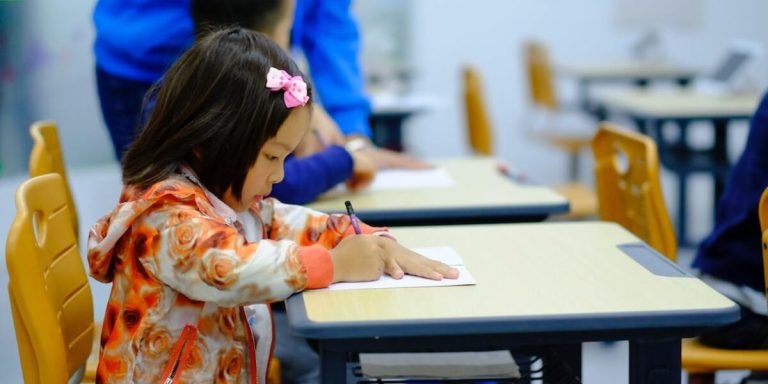K 12 Teacher: Navigating the Role in Modern Education
The role of a K 12 teacher has been evolving over the years with advancements in technology and changing educational philosophies. More than ever, they play a pivotal part not just in dispensing knowledge but also molding young minds to equip them for the future. Understanding this diversified role becomes essential as it bears direct implications on elementary school learning.
In modern education, navigating the responsibilities that come with being a K 12 teacher goes beyond lesson plans and grading papers; It’s about creating an environment conducive for holistic development – where students learn critical skills such as creativity, collaboration, communication and critical thinking alongside academics. This dynamic shift calls for teachers who can adapt swiftly while maintaining their core mission: promoting effective learning at each stage of childhood education.
Did you know?
Despite the challenges of modern education, it’s interesting to note that K-12 teachers not only instruct on core subjects but also tend to wear multiple hats such as counselors and social workers; showcasing their versatile role in shaping young minds.
Integrating Technology in the Elementary Classroom
In today’s digital era, integrating technology in the elementary classroom is no longer a luxury but a necessity. As K-12 teachers, it has now become our responsibility to integrate tech-based learning into our teaching philosophy as it keeps students engaged and facilitates better understanding of concepts.
The beauty of technological integration lies in its versatility. Be it an interactive smartboard used for storytelling or tablets loaded with educational games that promote problem-solving skills, every piece of modern technology brings something valuable to the table. It offers visual representation which can make abstract ideas more tangible and lessons more vibrant while encouraging active participation from all learners.
Moreover, we are living through times when education isn’t confined within four walls anymore – online tools help bring global resources right at children’s fingertips! From watching videos about rainforest ecosystems on YouTube to taking virtual field trips via Google Earth — integrating technology opens up infinite opportunities for exploratory learning beyond textbooks. And let’s not forget this approach also equips youngsters with essential 21st-century skills they’ll need to navigate their future careers successfully!
At the end of the day, however capable these technologies may be though; remember they’re just tools – effective integration still relies greatly upon us—the talented pool of K-12 teachers who know how best to use them efficiently & effectively based on each student’s personal needs & strengths!
Navigating Digital Tools for Interactive Learning
In the age of digitalization, it becomes paramount for a K-12 teacher to integrate technology in their traditional teaching methods. As we delve deeper into the realm of “Technology Integration in Education,” specifically focusing on “Elementary School Learning”, one can’t overlook the significance and inevitability of navigating through various digital tools for interactive learning.
Secondly, let’s take augmented reality (AR) as another excellent example. Picture an AR-based application transforming a flat image from textbooks into a 3D model animated right before children’s eyes! This immersive experience not only makes lessons exciting but also enhances students’ grasp on complex concepts at an early stage itself.
Thirdly, including game-based learning using consoles or educational software promotes active participation among learners while fostering teamwork skills simultaneously—an added bonus!
Lastly but most importantly, make use of online assessment platforms that help identify gaps in knowledge promptly so they could be addressed timely by teachers—a proactive approach towards betterment indeed.
As we steer forward through 2023 with these insights about integrating technological advancements successfully within elementary classrooms catering to distinctive learner profiles,it helps promote not just academic growth but holistic development too – emphasizing creativity,inquisitiveness,and other significant aspects beyond rote-learning.
Implementing Educational Apps to Enhance K-12 Instruction
K-12 teachers are constantly on the lookout for innovative ways to enrich and enhance student learning. In this digital age, educational apps prove an instrumental tool in achieving this goal. From improved engagement to personalized learning experiences, these technological marvels offer a myriad of benefits.
When it comes to integrating technology into elementary classrooms, implementing high-quality educational apps can make a significant difference. The right selection not only reinforces important concepts but also makes them more interactive and relatable for young minds.
One compelling advantage of using educational apps is their ability to adapt content according to individual learner needs. This personalization translates into increased understanding as students learn at their own pace without feeling pressured or left behind.
Furthermore, many kids today are already tech-savvy which means they quickly get comfortable with app-based interfaces allowing K-12 teachers easier implementation than traditional teaching tools like textbooks or whiteboards.
Another major factor favoring the use of ed-tech applications revolves around accessibility from home – a particularly crucial aspect considering how pandemic-induced remote schooling has become part-and-parcel of contemporary education scenarios across nations globally.
Strategies for Differentiated Instruction in a Diverse Elementary School Setting
Today’s dynamic elementary school classrooms brim with diversity, encompassing students of varied learning styles, abilities and cultural backgrounds. Thus it necessitates the adoption of differentiated instruction strategies by K-12 teachers in order to cater to individual student needs while ensuring a conducive environment for all learners.
Differentiated instruction is not just an approach; instead, it’s a philosophy that every child has unique strengths and talents which need recognition. Using technology as the backbone for differentiated teaching allows educators to give more personalized attention while also fostering independence among their students. The integration of modern digital tools like online quizzes or interactive apps enables real-time feedback on student performance aiding towards tailoring lessons accordingly.
Given this tech-driven era where Generation Alpha kids are born ‘swipe-ready’, leveraging appropriate technology can result in effective differentiation without causing disruption or adding extra workload upon our dedicated K-12 teachers.
Recognizing these diverse skills early on – through assessment tools powered by Artificial Intelligence – helps tailor activities based on each pupil’s competency levels thus providing them an optimal platform for academic success and overall growth.
Tailoring Lessons to Accommodate Multiple Learning Styles
In an increasingly diverse elementary school setting, tailoring lessons to accommodate multiple learning styles is no longer optional; it’s imperative. Both parents and K-12 teachers need effective strategies for differentiated instruction that leverage technology integration in education.
Recognizing each student’s distinct abilities and individual pace of learning is essential when crafting the perfect lesson plan. It involves adeptly using a range of digital tools designed especially for differentiating instructions according to students’ unique needs.
Typically there are four primary types of learners: auditory (learning by hearing), visual (learning by seeing), kinesthetic (learning by doing or moving) and reading/writing(prefering to read and write as their main mode). Each type necessitates a unique approach in delivering information which can readily be achieved through strategic use of AI-powered ed-tech platforms.
For instance, Auditory learners often benefit from educational podcasts or audiobooks whereas Visual ones may grasp concepts faster through infographics or animations available on various e-learning applications serving K 12 teacher community. Kinesthetic pupils thrive with interactive games while Reading/Writing fanatics get engaged with eBooks enriched with multimedia context cues— all these options were almost impossible without advances made in tech-integration domain within last few years.
Moreover, modern classroom management systems have enabled real-time tracking of students’ progress making assessment easier than ever before — giving educators insightful data at granular level assisting them curate customised content matched perfectly against kids’ ability levels thereby maximising engagement rates & retention degree simultaneously.
Addressing Varied Academic Needs with Personalized Teaching Methods
K-12 teachers in the current year, 2023, are faced with a broad range of academic needs within an elementary school setting. The rise of technology integration has accelerated their ability to address these varied learning requirements through personalized teaching methods.
Personalized teaching elevates traditional instruction by tailoring lessons to the unique skills and interests of each student. This approach builds on individual strengths while addressing areas for improvement. By customizing educational experiences at a granular level, K-12 teachers can effectively reach students from diverse backgrounds and abilities.
The incorporation of technology boosts these efforts exponentially. Through digital tools such as virtual reality (VR), augmented reality (AR), adaptive software programs or interactive whiteboards, educators now have more ways than ever before to engage learners actively in their education journey.
Virtual Reality provides immersive environments where abstract concepts become easy-to-understand realities; facilitating grasp that conventional classrooms may struggle to achieve.
Augmented Reality overlays computer-generated enhancements onto real-world objects which enhance understanding while providing interaction that makes them more appealing towards children’s natural curiosity.
Adaptive software adjusts its content based on learner’s performance with built-in mechanisms for progress monitoring thus allowing differentiation without increased workload for teacher.
Creative Approaches to Encourage Reading and Literacy Skills Growth
With K-12 teachers at the helm of this transformative journey, they employ various innovative methods to not only foster an interest for words but also build strong foundational cognitive abilities that make children resilient learners in later years. From engaging multimedia resources to interactive eBooks, tech-tools offer myriad options to supplement traditional teaching methodologies.
Moreover, these dynamic tools provide opportunities for personalized learning which is paramount when catering to each child’s unique academic needs. The inclusion of thoughtfully curated games or activities via educational apps also encourages self-paced exploration while reinforcing essential language arts concepts seamlessly into their study routines.
The interplay between technology and conventional pedagogical principles empowers K-12 teachers with robust instruments designed around modern learner requirements. By harmoniously merging them into daily classroom instructions, they ignite curiosity towards reading among youngsters besides developing well-rounded 21st-century citizens equipped with critical literacy skills necessary in today’s information-dense world.
Utilizing Storytelling Techniques To Spark Interest in Young Readers
In the fast-paced educational landscape of 2023, K-12 teachers today are consistently on the lookout for innovative methods to stimulate a love for reading in their pupils. One such powerful method that promises excellent results is integrating storytelling techniques while teaching literacy skills.
Storytelling has been an age-old tradition that ignites young minds’ curiosity and promotes active participation from children. Weaving stories into lessons creates vibrant learning spaces transforming ordinary classrooms into portals where fairy tales come alive, heroes embark on epic adventures, and there’s never a dull moment.
It all begins with creating characters your students can relate or aspire to be – it could range from everyday superheroes like firefighters or astronauts to mystical creatures like unicorns! The objective here is making sure these characters resonate with your learners so they’re more eager about reading their stories out loud in class (and at home).
Next comes setting up vivid surroundings within which our chosen hero navigates. This doesn’t just mean visually painting pictures through words; but also actively engaging other senses – smell of fresh country air as our protagonist treks lush green fields? Or perhaps sounds of animals hidden away in thick jungles he/she must cautiously tread?
Following this dynamic duo exercise serves twin purposes – firstly stimulating reader’s imagination beyond textual content improving comprehension levels secondly fostering empathy towards different life scenarios & cultures further broadening their worldly perspective.
Incorporating Multisensory Reading Activities Designed by K-12 Teachers
In an era where digital literacy is as vital as traditional reading skills, the role of a k 12 teacher in nurturing this growth cannot be overstated. A dynamic and innovative technique that educators are adopting to achieve these objectives involves incorporating multisensory reading activities into their curriculum.
A multisensory approach essentially means activating different senses — sight, sound, touch and even movement — at once during learning. This method can make reading more engaging for elementary-age students while helping them retain knowledge better than single-sense teaching methods.
Think about it from your childhood perspectives; wasn’t it easier to remember something you both saw and heard rather than only one or the other? For young learners especially, stimulating multiple senses simultaneously makes learning not just fun but also highly effective.
The benefits don’t stop there though! These interactive sessions lend themselves perfectly to integrating technology into education too. From using e-books with audio narration features on tablets to creating DIY sensory worksheets through online platforms – every component includes some form of technological interface.
Let’s talk specifics now: What do these K-12 teacher designed multimodal exercises look like?
Teachers might use text-to-speech software applications along with hardcopy books so children get visual exposure to words while hearing pronunciation—a two-birds-one-stone kind of situation!
Interactive apps offering games based around phonetic understanding help reinforce concepts learned in class enhancing auditory processing alongside cognitive engagement powered by strategic gaming experiences.
Conclusion
In the dynamic world of modern education, a K 12 teacher is more than just someone who imparts knowledge; they are guides, mentors and enablers navigating through various roles. They play an integral part in shaping young minds to confront future challenges with resilience and creativity. The role may be demanding but it’s equally rewarding for those passionate about molding tomorrow’s leaders.
Before signing off, remember this platform offers many other insightful pieces on childhood education that could add new dimensions to your understanding. We encourage you not only as educators or parents but as lifelong learners ourselves to explore further into our website where we break down complex topics into simple insights – there’s much more to discover!







